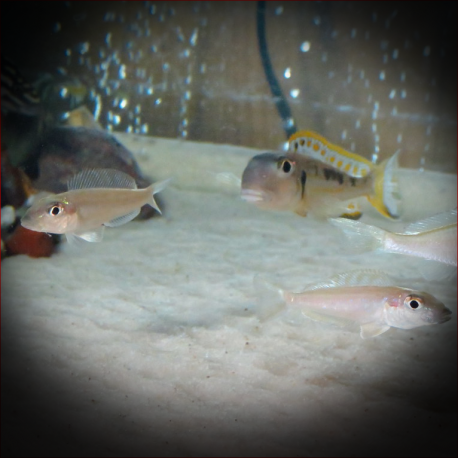More info
Datasheet
| Minimum Tank Size | 135 litres / 35.66 US gallons |
| Maximum Size | 16.0cm / 6.30inches |
| Temperature | 24°C / 75.20°F - 27°C / 80.60°F |
| Hardness | 10-25ºdH |
| pH | 7.5-9.0 |
General Description
The Black-Chinned Xenotilapia, scientifically known as Xenotilapia Melanogenys, is a cichlid species endemic to Lake Tanganyika. With slight geographical variations in color, these fish feed similarly to Geophagus species by sifting sand through their gills to extract hidden invertebrates. They exhibit skittish behavior and prefer staying in fixed shoals throughout their life, reacting nervously to sudden movements or light changes.
Aquarium Setup
To house Black-Chinned Xenotilapia, a tank of at least 135 liters with piles of rocks forming caves and open water spaces is ideal. A sandy substrate mimicking their natural habitat is necessary, alongside bright lighting. Water conditions of 7.5-9.0 pH, 24-27°C temperature, and 10-25°dH hardness are suitable for their well-being.
Behaviour
This species is peaceful yet skittish, making them incompatible with boisterous fish like Mbuna. Black-Chinned Xenotilapia exhibit territorial behavior, especially during spawning, requiring a balanced male-to-female ratio for optimal color development. They are peaceful towards their kind but may show territorial aggression during breeding times.
Feeding and Diet
Feeding predominantly on live and frozen foods obtained from the substrate, Black-Chinned Xenotilapia accept various food types but prefer live and frozen varieties. Adequate feeding is essential to ensure their nutritional needs are met, reflecting their natural scavenging behavior.
Reproduction & Dimorphism
Black-Chinned Xenotilapia engage in polygamous maternal mouthbrooding for reproduction. It is advisable to maintain a group of young fish for breeding purposes, given their sexual viability between 1-3 years of age. Males are larger with elongated fins, displaying vibrant colors during breeding. Females carry the brood of 10-80 eggs for up to 4 weeks before releasing free-swimming fry.
Habitat and Distribution
Endemic to Lake Tanganyika, Black-Chinned Xenotilapia are widespread in the lake, residing in massive shoals over sandy substrates. While typically inhabiting deep waters, they move to shallower regions for breeding. The species' distribution spans across the lake, forming fixed shoals throughout their natural habitat.

